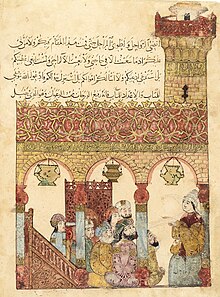Al-Mustansir I
| Mansûr al-Mustansir bi-llah المنصور المستنصر بالله | |||||
|---|---|---|---|---|---|
Abbasid Caliph in Baghdad | |||||
| Reign | 10 July 1226 – 5 December 1242 | ||||
| Predecessor | al-Zahir | ||||
| Successor | al-Musta'sim | ||||
| Born | 17 February 1192 [1] Baghdad, Abbasid Caliphate, (now Iraq) | ||||
| Died | 5 December 1242 (aged 50) Baghdad, Abbasid Caliphate | ||||
| Burial | Baghdad | ||||
| Consort | Shahan Hajir[2] | ||||
| Issue | Al-Musta'sim | ||||
| |||||
| Dynasty | Abbasid | ||||
| Father | al-Zahir | ||||
| Mother | Zahra | ||||
| Religion | Sunni Islam | ||||

Al-Mustansir Bi'llah (full name:Abû Ja`far al-Mustansir bi-llah al-Mansûr bin az-Zâhir
Biography
Al-Mustansir was born in Baghdad on 1192. He was the son of Abu Nasr Muhammad (future caliph
was Abu Jaʿfar. At the time of his birth, his father was a prince. When his father ascended to the throne in 1225. His father, lowered the taxes of Iraq, and built a strong army to resist invasions. He died on 10 July 1226, nine months after his accession.On his father's death in 1226 he has succeeded his father
The ruler of Erbil, Muzaffar ad-Din Gökböri was being without a male heir, Gökböri willed Erbil to the Abbasid caliph al-Mustansir.[10] After the death of Gökböri in 1233, the Erbil city came under Abbasid control.
Al-Mustansir died on 5 December 1242.[11] His son Al-Musta'sim succeeded him as the thirty-seventh and last Caliph of the Abbasid Caliphate.
Family
One of Al-Mustansir's concubines was Shahan. She was a Greek, and had been formerly a slave of Khata Khatun, the daughter of the commander Sunqur al-Nasiri the Tall and the wife of the commander Jamal al-Din Baklak al-Nasiri. After Al-Mustansir's accession to the throne, Khata presented Shahan to him as a gift, as part of a group of slaves. Shahan alone among them became his concubine and favourite.[12] Another of his concubines was Hajir. She was the mother of the future Caliph Al-Musta'sim.[13]
See also
- Sixth Crusade (1228–1229), a military expedition to recapture the city of Jerusalem from Muslims.
References
- ^ Ibn Kathir: Albidayah Wa-Nahaya, V. XIII. p. 147
- ^ Al-Hawadith al-Jami'a . Ibn al-Fuwaṭi
- .
- ^ Arabic : abū jaʿfar al-mustanṣir bi-llāh al-manṣūr ben aẓ-ẓāhir,
أبو جعفر المسنتصر بالله المنصور بن محمد الظاهر - ^ Arabic : Al-Mustanṣir, المسنتصر بالله
- ISBN 978-9987-9022-4-8.
- ^ Hasan, M. (1998). History of Islam: Classical period, 571-1258 C.E. Islamic Publications. p. 304.
- OCLC 30319450.
- OCLC 37265778.
- ^ Morray, p. 85
- ^ 10 Jumada ath-thani 640 A.H.
- ISBN 978-1-4798-6679-3.
- ISBN 978-9987-9022-4-8.
Sources
- This text is adapted from William Muir's public domain, The Caliphate: Its Rise, Decline, and Fall.
- Hasan, M. (1998). History of Islam: Classical period, 571-1258 C.E. History of Islam. Islamic Publications. p. 304
- Al-Maqrizi, Al Selouk Leme'refatt Dewall al-Melouk, Dar al-kotob, 1997.
- Morray D.W. (1994) An Ayyubid Notable and His World: Ibn Al-ʻAdīm and Aleppo as Portrayed in His Biographical Dictionary of People Associated with the City, Brill. Leiden. ISBN 9004099565
- Al-Sāʿī, Ibn; Toorawa, Shawkat M.; Bray, Julia (2017). كتاب جهات الأئمة الخلفاء من الحرائر والإماء المسمى نساء الخلفاء: Women and the Court of Baghdad. Library of Arabic Literature.
